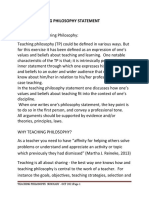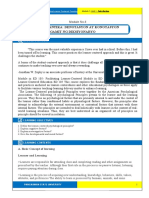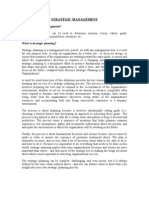Educ 4a-Exercises-No 1
Educ 4a-Exercises-No 1
Uploaded by
Eddie Mamusog AwitCopyright:
Available Formats
Educ 4a-Exercises-No 1
Educ 4a-Exercises-No 1
Uploaded by
Eddie Mamusog AwitOriginal Title
Copyright
Available Formats
Share this document
Did you find this document useful?
Is this content inappropriate?
Copyright:
Available Formats
Educ 4a-Exercises-No 1
Educ 4a-Exercises-No 1
Uploaded by
Eddie Mamusog AwitCopyright:
Available Formats
Exercises No.
Loukie Calogmoc
Answer the following questions:
1. What is your concept of the meaning of principles as used in teaching and
in learning?
My concept of The Principles of Teaching, Learning and Assessment focus on
the provision of a school and class environment that is intellectually, socially and
physically supportive of learning. The principles assist whole-school planning and
individual classroom practice. It is essential, therefore, to ensure that there is a
shared understanding of them within particular school communities and a
collaborative effort to implement these principles in ways appropriate to individual
schools.
2. What are the major functions of principles in teaching?
Principles are the chief guides to make teaching and learning intelligent and
productive. ADVERTISEMENTS: They are the fundamentals through which we proceed
from one situation to another. Principles are important for the governing of actions and
the operation of techniques in any field of education.
3. What are the three types of principles and how are they related to one another as
far as teaching is concerned?
Starting Principles:
These involve the nature of the child, his psychological and physiological endowments
which make education possible.Our native equipment’s have been called by various
names. The most common terms used are reflexes, instincts, capacities, impulses,
temperaments, and the like.These hereditary endowments are the preliminary concern
in all educational Endeavour. In the language of A vent- “the child’s original nature is
absolutely antecedent and initial to all educational activities and results”.
Guiding Principles" are a broad philosophy that encompass your personal
beliefs and values and guide an organization throughout its life in all
circumstances, irrespective of changes in its goals, strategies or type of work.
They create a company culture where everyone understands what's important.
Ending Principles:
These refer to the educational aims, goals, objectives, outcomes, or results of the
whole educational scheme to which teaching and learning are directed. ... By the
aims of education we mean the ends toward which the educative process is
moving.
4. What are the advantages of grouping the students according to
intelligence? What are some of the disadvantages?
Advantage Aspects of Ability Grouping
Students Are Not Forced To Wait Or Rush
When you place students of the same ability together, they usually are able to work at
about the same pace. This means the students that understand the concept you are
teaching can move on to a more advanced stage and the ones that need extra guidance
can slow down and get extra help. No one is waiting on someone else to grasp a
concept (that they already understand) and no one is being forced to move on before
they are ready.
Disadvantage Aspects of Ability Grouping
Students May Get “Stuck” In a Group
It is important to remember that no student is perfect at everything and no student is
bad at everything. Sometimes, when we ability group it is easy to label students and
place them in the same low, middle, or high group time after time. This can lead to
labeling, (the “nerdy group” or the “dumb group”) something teachers want to avoid at
all costs. Afterall, a huge part of our job is to make our students feel confident and
secure.
5. Why should the nature of the child rather than the nature of the subject
matter determine the nature of teaching?
Because The more you learn about where your students come from, the
easier your job will become. This includes learning more about their language,
culture, values, family, and home environment. This knowledge will help you to
better support your students in the classroom and to receive more support from
home
You might also like
- Pedagogical Leadership. Baird - CoughlinDocument5 pagesPedagogical Leadership. Baird - CoughlinChyta AnindhytaNo ratings yet
- HFLE PortfolioDocument57 pagesHFLE PortfolioDaniel Dowding100% (1)
- Types of Teaching PrinciplesDocument9 pagesTypes of Teaching Principlesbadong100% (1)
- Teaching Music IN Elementary Grades: Course ObjectiveDocument15 pagesTeaching Music IN Elementary Grades: Course ObjectiveEddie Mamusog Awit100% (1)
- Teaching Science IN The Elementary Grades (Biology and Chemistry)Document23 pagesTeaching Science IN The Elementary Grades (Biology and Chemistry)Eddie Mamusog Awit86% (14)
- Bule Hora University College of Education and Behavioral Sciences Guji Girja CampusDocument12 pagesBule Hora University College of Education and Behavioral Sciences Guji Girja Campusmekit bekeleNo ratings yet
- Ped 7Document40 pagesPed 7Keanna TruitaNo ratings yet
- Ed 105 Rhejean Basa Beed Iii-ADocument11 pagesEd 105 Rhejean Basa Beed Iii-ARhejean BasaNo ratings yet
- Scope of Educational PsychologyDocument2 pagesScope of Educational PsychologyAgrippa Mungazi82% (17)
- Philosophy of education New_035746_083033Document32 pagesPhilosophy of education New_035746_083033oswardmathias006No ratings yet
- SG4-Focus On ClassroomDocument5 pagesSG4-Focus On ClassroomFate VargasNo ratings yet
- Principles and Method of Teaching: Facilitative Learning EnvironmentDocument9 pagesPrinciples and Method of Teaching: Facilitative Learning EnvironmentCristyl BalintongNo ratings yet
- Adult Learning TheoryDocument11 pagesAdult Learning TheoryKuna 96100% (1)
- 7 Habits of Highly Effective PeopleDocument7 pages7 Habits of Highly Effective PeopleJM MacatangayNo ratings yet
- The Meaning and Importance of Principles of TeachingDocument20 pagesThe Meaning and Importance of Principles of TeachingVira LledoNo ratings yet
- Module 2 Learner Centered ScriptDocument6 pagesModule 2 Learner Centered ScriptJoey PerezNo ratings yet
- Attributes and Distinctive Features of Adult Learning and (Autosaved) (Autosaved)Document32 pagesAttributes and Distinctive Features of Adult Learning and (Autosaved) (Autosaved)Mericar EsmedioNo ratings yet
- Role of Education Psychology and Its Benefits For Teachers and Learners.Document8 pagesRole of Education Psychology and Its Benefits For Teachers and Learners.aishimohamedNo ratings yet
- Teaching Philosophy Summary - Oct 2021Document4 pagesTeaching Philosophy Summary - Oct 2021Kago Aeon TlhagaleNo ratings yet
- Educational PsychologyDocument24 pagesEducational PsychologyBích NgọcNo ratings yet
- Unit 4-Focus On Clasroom Processes: Module OverviewDocument6 pagesUnit 4-Focus On Clasroom Processes: Module OverviewMAYLENE CALICDANNo ratings yet
- Foundations of Learning Environments ProjectDocument11 pagesFoundations of Learning Environments Projectapi-596436208No ratings yet
- Ttatc NotesDocument15 pagesTtatc NotesJera RagasajoNo ratings yet
- Evocation & Role PlayingDocument8 pagesEvocation & Role PlayingCath CathNo ratings yet
- Report Final Teac 21Document29 pagesReport Final Teac 21Robin Escoses MallariNo ratings yet
- Frosted Glass Star Business Product IntroductionDocument35 pagesFrosted Glass Star Business Product IntroductionPoblacion, Brien S.No ratings yet
- Bte2601 Assignment 2Document8 pagesBte2601 Assignment 2Thembi AliceNo ratings yet
- Reflections On How To Be A Highly Effective Primary TeacherDocument5 pagesReflections On How To Be A Highly Effective Primary Teacherjosephinecomboy04061982No ratings yet
- Psycho PhiloDocument7 pagesPsycho PhiloInsekto BitesNo ratings yet
- Module 1 - PSTMLSDocument53 pagesModule 1 - PSTMLSArvie Karl NabiNo ratings yet
- Group 5Document22 pagesGroup 5Rhoevy DavilaNo ratings yet
- Educational PsyDocument8 pagesEducational Psyhina.mirNo ratings yet
- Nursing Teaching and Learning Principles General Learning PrinciplesDocument6 pagesNursing Teaching and Learning Principles General Learning PrinciplesPatrickAnteNo ratings yet
- Philosophy of Learning PaperDocument5 pagesPhilosophy of Learning Paperapi-535189791No ratings yet
- Final Copy David Philo Unit 102082 Philosophy of Classroom Management Document R 2h2018Document15 pagesFinal Copy David Philo Unit 102082 Philosophy of Classroom Management Document R 2h2018api-408497454No ratings yet
- REFLECTIONDocument3 pagesREFLECTIONChenna RoseNo ratings yet
- Educ 3Document19 pagesEduc 3Kurt Louie LiwanaganNo ratings yet
- Principles of Learning LectureDocument39 pagesPrinciples of Learning Lectureimee eusebio100% (1)
- Example of Intrinsic Motivation StrategiesDocument3 pagesExample of Intrinsic Motivation StrategiesdotdotPindotNo ratings yet
- Educational Counselling-Cns 169Document81 pagesEducational Counselling-Cns 169Keerthana Sarankan100% (1)
- Guiding Principles in Determining and Formulating Learning ObjectivesDocument3 pagesGuiding Principles in Determining and Formulating Learning ObjectivesKein Balneg VerzanoNo ratings yet
- Module 1 FaciDocument6 pagesModule 1 FaciAllysa Shane Paningbatan RascoNo ratings yet
- Philosophy of EducationDocument11 pagesPhilosophy of EducationMark Pasang Dela CruzNo ratings yet
- LEARNER Centered PrinciplesDocument5 pagesLEARNER Centered PrinciplesTata Duero LachicaNo ratings yet
- contents-GMT - modifiedDocument34 pagescontents-GMT - modifiedawokegoshiNo ratings yet
- Techniques of Teaching 2Document12 pagesTechniques of Teaching 2joannNo ratings yet
- Sociology AssignmentDocument19 pagesSociology AssignmentHarbhajan SinghNo ratings yet
- Guidance Midterm ExamDocument13 pagesGuidance Midterm ExamJuhainah GuroNo ratings yet
- Educ 311: Facilitating Learner - Centered Teaching: Divine Grace V. Galorio Beed-IiiDocument3 pagesEduc 311: Facilitating Learner - Centered Teaching: Divine Grace V. Galorio Beed-IiiDivine Grace Villanueva Galorio100% (2)
- ) Educational Phychology - 2022-2023Document27 pages) Educational Phychology - 2022-2023JUSTINENo ratings yet
- SG1 Learner Centered Psychological PrinciplesDocument5 pagesSG1 Learner Centered Psychological PrinciplesFate VargasNo ratings yet
- Sed464 Safinal CwiattDocument19 pagesSed464 Safinal Cwiattapi-456058932No ratings yet
- Ued 495-496 Spivey Stacy Artifact Classroom Management PlanDocument10 pagesUed 495-496 Spivey Stacy Artifact Classroom Management Planapi-337457106No ratings yet
- Working With Adults As Learners:: Theory and PracticeDocument31 pagesWorking With Adults As Learners:: Theory and PracticeLei Anne Kate DimailigNo ratings yet
- Fostering Student Motivation and Engagement MOOCDocument9 pagesFostering Student Motivation and Engagement MOOCEdith Mutindi KavooNo ratings yet
- DONE MYLENE JOY GALAMITON - Module 2 Lesson 1Document10 pagesDONE MYLENE JOY GALAMITON - Module 2 Lesson 1Mylene Joy Cabariban GalamitonNo ratings yet
- GEE-PMT Module 4 Week 6-7Document4 pagesGEE-PMT Module 4 Week 6-7TimothyLimNo ratings yet
- FINAL EXAM PHD-SUMMER 2020 (Sanny Ferrer)Document10 pagesFINAL EXAM PHD-SUMMER 2020 (Sanny Ferrer)Joseph Caballero CruzNo ratings yet
- Module 1 FaciDocument6 pagesModule 1 FaciALLYSA RASCONo ratings yet
- Unit 1 - Introduction: Module OverviewDocument8 pagesUnit 1 - Introduction: Module OverviewJed GarciaNo ratings yet
- Teaching Scaffolding To Early Childhood Educators: Action Research in Supportive Learning PracticesFrom EverandTeaching Scaffolding To Early Childhood Educators: Action Research in Supportive Learning PracticesNo ratings yet
- Enhancing Classroom Environment: Through Motivation and MindfulnessFrom EverandEnhancing Classroom Environment: Through Motivation and MindfulnessNo ratings yet
- Demonstration Teaching Evaluation Form S.Y 2020-2021Document3 pagesDemonstration Teaching Evaluation Form S.Y 2020-2021Eddie Mamusog AwitNo ratings yet
- ALS Assessment Form 1 ILA 1 and 2Document2 pagesALS Assessment Form 1 ILA 1 and 2Eddie Mamusog Awit95% (43)
- Fundamentals in Lodging Operations (HMP 3) : Course DiscriptionDocument3 pagesFundamentals in Lodging Operations (HMP 3) : Course DiscriptionEddie Mamusog AwitNo ratings yet
- Class Schedule HMDocument2 pagesClass Schedule HMEddie Mamusog AwitNo ratings yet
- Mati Polytechnic College, Inc.: Education DepartmentDocument2 pagesMati Polytechnic College, Inc.: Education DepartmentEddie Mamusog AwitNo ratings yet
- Department - BSHM HMP 5Document15 pagesDepartment - BSHM HMP 5Eddie Mamusog Awit100% (1)
- Assessment Focus of Project-Based LearningDocument1 pageAssessment Focus of Project-Based LearningEddie Mamusog Awit100% (1)
- Character Formation With Leadershop, Decision Making, Management and Administration (CFLM 2) Prepared By: Jejie M. Awit., LPTDocument22 pagesCharacter Formation With Leadershop, Decision Making, Management and Administration (CFLM 2) Prepared By: Jejie M. Awit., LPTEddie Mamusog Awit100% (3)
- Character Formation With Leadershop, Decision Making, Management and Administration (CFLM 2)Document48 pagesCharacter Formation With Leadershop, Decision Making, Management and Administration (CFLM 2)Eddie Mamusog Awit100% (4)
- Life Science: Molecules To Organisms: Structures and ProcessesDocument5 pagesLife Science: Molecules To Organisms: Structures and ProcessesEddie Mamusog AwitNo ratings yet
- Teaching Social Studies in Elementary Grades (Culture and Geography)Document4 pagesTeaching Social Studies in Elementary Grades (Culture and Geography)Eddie Mamusog Awit67% (6)
- Pagtuturong Filipino Sa Elementrya Estructura at Gamit Ang Wikang FilipinoDocument2 pagesPagtuturong Filipino Sa Elementrya Estructura at Gamit Ang Wikang FilipinoEddie Mamusog AwitNo ratings yet
- ResumeDocument2 pagesResumeEddie Mamusog AwitNo ratings yet
- Teaching Science IN Elementary (Physics, Earth and Space Science)Document47 pagesTeaching Science IN Elementary (Physics, Earth and Space Science)Eddie Mamusog AwitNo ratings yet
- Assignment of Education in Pakistan Problems, Issues and TrendsDocument39 pagesAssignment of Education in Pakistan Problems, Issues and TrendsAkbar ZarnazNo ratings yet
- Step 3 Lesson Plan-2 1Document8 pagesStep 3 Lesson Plan-2 1api-401005211No ratings yet
- District Innovation Proposal - Project MindDocument11 pagesDistrict Innovation Proposal - Project MindJessica Ann Manalo Sese100% (5)
- Research - Eng10 - G3 - Perceived Effects of The Citizenship Training Program On Academic Performance of Grade 10 Students in BNHSDocument6 pagesResearch - Eng10 - G3 - Perceived Effects of The Citizenship Training Program On Academic Performance of Grade 10 Students in BNHSits meNo ratings yet
- Jean Piagets Cognitive DevelopmentDocument5 pagesJean Piagets Cognitive DevelopmentluckyykhaiNo ratings yet
- Seminario de San Jose: Background Knowledge Probe Misconception or Preconception Check Pro and Con GridDocument2 pagesSeminario de San Jose: Background Knowledge Probe Misconception or Preconception Check Pro and Con GridKARLO MARKO VALLADORESNo ratings yet
- What Is Strategic Management?Document11 pagesWhat Is Strategic Management?singhpritam84No ratings yet
- Business Communication - Study Material I MBADocument102 pagesBusiness Communication - Study Material I MBAPerumal DMNo ratings yet
- AttentionDocument22 pagesAttentionUdisha Merwal100% (2)
- Classroom Cybernetics: An Approach For Effective and Efficient Classroom TeachingDocument9 pagesClassroom Cybernetics: An Approach For Effective and Efficient Classroom Teachingpatatas potatoNo ratings yet
- Module 3 Facilitating LCTDocument5 pagesModule 3 Facilitating LCTkushy aine100% (1)
- McMaster Model of Family FunctioningDocument13 pagesMcMaster Model of Family FunctioningRuth Nina80% (5)
- Math KindergartenDocument18 pagesMath KindergartenJitsNavin100% (4)
- Division of Biñan City: Self - Learning ModuleDocument5 pagesDivision of Biñan City: Self - Learning ModuleBayoyong NhsNo ratings yet
- Barangay Profile For SIPDocument5 pagesBarangay Profile For SIPRandy-IanRexLorenzo100% (1)
- I Dedicated This Research To My Family Who Had Supported Me Throughout The ResearchDocument10 pagesI Dedicated This Research To My Family Who Had Supported Me Throughout The ResearchMarilyn RebatoNo ratings yet
- Current Trends in Early Childhood EducationDocument2 pagesCurrent Trends in Early Childhood EducationPAKK10622 MOHAMAD IDZWAN NAZIM BIN IDRISNo ratings yet
- Colegiul Naţional "Mihail Sadoveanu", Paşcani, Judeţul IaşiDocument6 pagesColegiul Naţional "Mihail Sadoveanu", Paşcani, Judeţul IaşiLeezukaNo ratings yet
- Lecture 1 Introduction Knowledge and KM LatestDocument30 pagesLecture 1 Introduction Knowledge and KM LatestYean QinNo ratings yet
- Mastering Reasoning Skills in Learning Differentiation Using The Marzano's StrategyDocument8 pagesMastering Reasoning Skills in Learning Differentiation Using The Marzano's StrategyNorhapidah Mohd SaadNo ratings yet
- The Look by SartreDocument4 pagesThe Look by Sartreaditya choudharyNo ratings yet
- Job Satisication 3Document4 pagesJob Satisication 3Govindarajan BangaruNo ratings yet
- Ideas Pertaining To A Pure Phenomenology and To A Phenomenological Philosophy - Second Book Studies in The Phenomenology of Constitution (PDFDrive)Document454 pagesIdeas Pertaining To A Pure Phenomenology and To A Phenomenological Philosophy - Second Book Studies in The Phenomenology of Constitution (PDFDrive)puja sarmahNo ratings yet
- Roll Record Teen NumbersDocument4 pagesRoll Record Teen Numbersapi-237967028No ratings yet
- Local Review of Related LiteratureDocument7 pagesLocal Review of Related Literaturejehiel catanduanesNo ratings yet
- Day 1 - Solids LiquidsDocument5 pagesDay 1 - Solids Liquidsapi-547095778No ratings yet
- 8625 Solved Assignment No 2Document15 pages8625 Solved Assignment No 2Danial KhadimNo ratings yet
- History of Language TeachingDocument6 pagesHistory of Language TeachingBình HồNo ratings yet
- Design and Technology: An International JournalDocument115 pagesDesign and Technology: An International JournalTecnología Fácil (TecnoFacilMX)No ratings yet
- Lesson 1. Argumentation and Debate DefinedDocument3 pagesLesson 1. Argumentation and Debate DefinedAspher Ian GummongNo ratings yet









































































































